Target sighted. Target confirmed.
Now that The Force Awakens is poised to overtake Avatar as the top grossing film of all time, this seems like a great time to revisit Pete Fenzel’s classic 2010 analysis of why Avatar sucks. Back in 2009, I actually tried to defend this film on the OTI Podcast, but with 6 years of hindsight, I have to concede what many of you knew all along– Fenzel was right. For more in-depth analysis of films that don’t suck, check out our Overview series of alternative commentary tracks, which cover Star Wars, Independence Day, Terminator 2 and many other films that don’t suck . –Ryan Sheely
This is the follow-up to 5 Reasons Avatar Will Suck, enhanced by the fact that, at this point, I have seen the movie. Feel free to go back and see how prescient I was. This one has spoilers; the last one did too, but they don’t count, because it’s not a spoiler if the movie just happens to be predictable. You have to see it first.
Barring the few slobbering orientalists who get jazzed by how Avatar fetishizes the exotic, everyone I’ve talked to has the same basic opinion of this winter’s biggest megamovie — the visuals are groundbreaking and all fancy (and crap), but the characters and story are not so good (and crap). Overall judgements on the film seem to differ based on the watcher’s priorities. Which is more important, spectacle, or the other five Aristotelian elements of drama?
If you’re the kind of movie-watcher who values shiny objects over all else, you probably love Avatar, and I don’t know if Overthinking It can do much for you other than recommend some other all time cinematic greats.
But if you are the kind of movie-watcher who sees movies as a medium for storytelling, Overthinking It can do quite a bit more for you. We can vindicate you. We can set you free. We can speak truth to power. And we can go back later, see whether or not we were right, and talk about ourselves.
We can tell you why Avatar sucks. We can even add a sixth reason, because we’ve actually seen it this time. It’s a new year, with new possibilities and new, higher Arabic numerals.
![]()
Reason #6: The avatars suck
Initial assessment: “An avatar has the power to turn an otherwise decent, functional person into either a raving idiot or a certifiable freakshow. Naming the movie after one implies similar debasement — such a flick is already fighting an uphill battle against suckitude.”
Verdict: CORRECT
Before Avatar came out, I heard plenty of chatter about how believable the computer-generated Na’vi bodies were going to be. Thanks to James Cameron’s innovative “performance capture” technology, they were going to transcend traditional the limits of the believability of CGI characters. They were going to shatter the Final Fantasy: The Spirits Within barrier. Or, you know, they were going to at least not fall back behind the barriers that Gollum shattered seven years ago.
Cameron succeeded. The CGI Na’vi and CGI Avatars look great. The physicality is off sometimes, but the “performance capture” technology works, and some of the shots make them really look like they’re actually there.

Abrose Burnside perfected the art of looking realistic in pictures long before it was fashionable or cost a hundred million dollars.
However, consider this: While the Na’vi are an achievement in computing and filmic tech, “really looking like you’re actually there” and “walking and making a facial expression without alarming and creeping out the audience” are things Andrew McCarthy does 70% of the time he’s on camera. Your local gas station attendant does them 100% of the time on his security cam, even though he never watches the tapes.
Cameron managed to raise the level of CGI acting to that of the basic human being photographed. This is only an achievement because, other than Gollum, almost nobody had ever done it before. Oh, and because it was difficult and expensive.
But this accomplishment in itself doesn’t mean including the avatars in Avatar makes the movie better. It just means there’s a limit to the degree that they can make it worse.
Now we have these fancy cat bodies, what did Avatar actually do with them? I’m most interested here in Avatar’s avatars, the simulated, generically engineered catsuits. My charge in my initial article was that the movie avatars would function like online avatars — that they would prompt the characters to “descend” (from the Sanskrit) from being already pretty lame to being straight-up awful. I posited that being in an avatar is going to bring out the lamest in somebody, real or fictional.
This is a pretty good summary of what happens to the characters who take control of Na’vi avatars. There are three of them of note — Sigourney Weaver, who goes from being a pretty boring caricature of a wonkish academic sociologist to a naïve nonfactor in a crop top. There’s Jake Snaggletooth Hammerstein or whatever Sam Worthington’s name is, who goes from being an angsty paralyzed former vet who is loyal to the military to being neither angsty, nor paralyzed, nor loyal to the military, and just kind of an action movie cliché. Then there’s sort-of-goatee guy, who goes from being “in the movie” to being “not in the movie.”
I’d say that’s descent on all counts.
A shadow of my former self
But that’s not quite why the avatars suck. They suck because they make the story malfunction. The movie is already emotionally slow, clunky and inelegantly plotted, and the characters are flat and poorly developed. The avatars are responsible for making both these things worse.
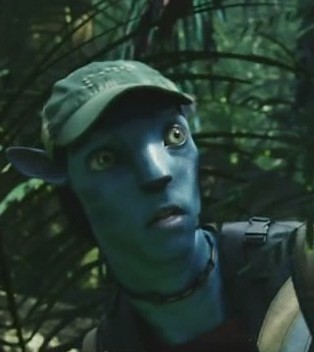
This sucks.
When you present a character in any visual medium, from Hogarth to Verhoeven, the design of the character matters. Maybe this design is the work of an actor, maybe it is done by a cartoonist, but it gives you an instant idea of who the character is and what the character is like. Film (digital or chemical) is a visual medium, and the first impression a character makes is visual.
The avatars sort of have the faces of the actors who perform their voices and gestures, but they don’t look like those actors enough that you instantly and subconsciously connect them with their corresponding human characters. When Jake’s avatar is onscreen, there’s no “Oh, there’s Jake!” moment of comprehension. The avatars present such a divergence from what the character looks like, that when they first appear, they register as new characters and have to be introduced to us all over again.
This is compounded by the trope that the avatars represent a rebirth or baptism of the main characters. As avatars, they don’t have any of the problems they had as people. Jake Jakerson can walk, Sigourney Weaver doesn’t smoke and is younger and more vigorous, and sort-of-goatee guy stops being a random douche and becomes an extra. This is supposed to communicate an Emersonian message about the constant possibility for transcendent rebirth in the context of nature, but what it does in practice is negate the time spent in the beginning of the movie on character development. The characters don’t hold onto their shit, which means the shit you learn about the characters up front has little payoff and can’t inform the action.
Let me reiterate this, because a lot of people have misunderstood me when I’ve talked about it — if you take away a character trait you spent time developing, then it doesn’t fulfill its role of informing the action.
This is not the same as saying it doesn’t mean anything or that it accomplishes nothing in the story. Sure, it accomplishes the whole Emersonian thing I just talked (err, wrote) about. But character development isn’t just about what the characters mean or what the story is about — character development is an important part of what makes the performances in a movie emotionally engaging and interesting. In order to develop sympathies with the characters, we need to know stuff about them — even if it’s only known on impression and not explained to us (for example, we never care why Steve Urkel is the way he is, but we know a bunch of stuff about him based on what he looks like and how he talks — that’s still character development).
The example I keep bringing up IRL rants: At the beginning of the movie, we learn two things that are really important about Jake.
- Jake has a dead twin brother.
- Jake is paraplegic.
Once Jake gets in the avatar, neither of these things matter.
This is by design, but it creates a huge problem in the story, which is that Jake’s character was really strongly identified with these things, and now Jake’s character is just gone. He isn’t grounded in anything. His attitudes and emotional reality evaporate. There’s very little to inform what he does. It’s a lot like Star Trek V, which I’ve talked about before many times. Jake needs his pain — he needs it to be in the movie.
The characters are flat and the story seems slow because Cameron doesn’t solve the problem that the avatars create when they wipe the histories of the main characters more than a half-hour in. The reboot and rehashing become more boring from an emotional standpoint than they have to be. The drama in a lot of the scenes is siphoned off. A lot of scenes that might have worked in isolation don’t work in the movie, and the resulting failures (the worst being when Jake Francois Vermouth blows off the opportunity to get his legs back as if it ain’t no thing) just sit there heavy, viscous and misshapen – like turds.
I’ve said many times since seeing Avatar that the movie would have been far, far better if Jake started in the avatar. The lead-in is pretty, but it’s a waste of time, not just because you’re talking about doing something rather than just doing it (in an action movie no less) — but because, in this specific movie, because of the specific story you are serving, when you get to the avatars, you have to undo most of the exposition work you have done anyway and introduce the characters all over again. Start the movie later, and you dump a bunch of the dead weight.
Three other, far better ways to handle the visual presentation of the avatars —
- Handle it like Virtuosity or The Matrix, where people look the same in their own bodies as in their artificial representations of bodies. Tricky in this context, but possible, depending on how presentational you want to get.
- Handle it like the Mighty Morphin’ Power Rangers, and give us very obvious visual clues as to who each character is when they transform. Their street clothes match their outfits match their Megazords, and their names are there colors and tell you which one is which in all three places. A lot of video games do this when they transform characters into animals. See The Legend of Zelda: Twilight Princess for some good examples.
- Handle it like Transformers: Beast Wars, and don’t delay. Switch the characters back and forth frequently, and show the changeover onscreen, so the audience can make the association.
Or, you know, you can just shove a giant chicken bone down your story’s throat in the name of technology.
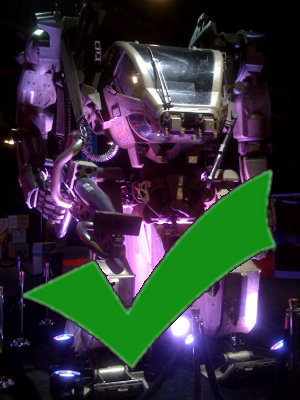
To quote myself: “Nice windshield, idiot.”
Reason #5: The giant power armor sucks
Initial assessment: “Because, you know, nobody is going to shoot or direct smashitude at the part of your automated steel battlesuit that is either glass or totally exposed, right? If they did, you’d want to encase it in something that would offer you meaningful protection, and that would be too smart.”
Verdict: CORRECT
True to form for movies like this, the technology the humans employ in Avatar is poorly suited to combat with the Na’vi to a comical degree. True to my expectation, the villain is killed by arrows shot through the giant glass window of his steel battlesuit. Arrows. Wooden arrows. Against a space marine. Disgusting.
We talked about it on the “Are We Human, or Are We Panther?” podcast — sure, you don’t really want to be the guy who calls a movie awful just because the tactics employed by fictional armies using fictional weapons are stupid. “This movie sucks because those guys stood in a circle and shot inward so that they are almost guaranteed to hit each other” is no way to go through life — or Starship Troopers. But sometimes you need to make an exception, especially when it’s important to the story.
It was awful not just how idiotically, but how predictably the battle armor worked out. The final battle armor fight is pretty cool, but it only has the chance to be pretty cool because the villain has been severely handicapped by dumb clichés. Sure, the mecha suit is a parallel to the avatar — technology versus biology as a second body, and that has some depth — but the avatars are also products of technology (human technology, ‘natch), so in the end this doesn’t really matter. In the end, the arrow through the glass is stupider and suckier than the symbolism of the armor is cool and smart.
And it’s just tiresome how many mistakes the humans have to make to throw this game. Being a human in Avatar is like playing for the New York Mets — no matter how great things seem to be going for you, you are eternally courting improbable and embarassing failure. All they have to do is put on some masks, dig a trench around the Home Tree, put a bunch of guys in the trench with rifles, and ship them air and rotate them back to base every once in a while. You can even just put in a few pillboxes and fill them with non-toxic breathable goodness and a latrine for emergencies. If the humans do that, there is no possible way the Na’vi are going to drive them out. No possible way. If they walk out in the open, they get killed with machine guns. They only survive if they stay under cover. They have no way of cutting the human supply lines, provided the human supply lines are in the open and protected by machine guns.
We had a time in human history when a whole bunch of folks tried to defend their homeland by calling together all their able bodied men to charge on foot and horseback with courage and vigor at a fortified position defended with automatic weapons and modern communications capability. It was called World War I. It didn’t work. We had a time when elite divisions of the world’s best cavalry charged a position armed mostly with muzzle-loaded cannon. It’s known now as the “Charge of the Light Brigade,” and it was really stupid, and a lot of people died for no gain.
So, anyway, in the plan that works, every once in a while, you move the trench forward a little, until you can shell the tree with artillery for a few weeks and seize the unobtanium (gag). The Na’vi would stand no chance against humans with 19th-century military technology, dragon troopers or no. Heck, it would be the same against 18th century military technology. Their “wait in your house until your friends arrive, then run at the bad guy yelling with sticks just before they show up” strategy might work against a human military in the modern era one time out of a hundred — maybe — but not more than that. The Na’vi would definitely get their thong-clad butts (more on that later) handed to them by Genghis Khan. Heck, the Na’vi would probably lose to a Roman Legion that had the patience to carry out a proper siege using wooden palisades defended by rock-slingers and catapultae, provided they had something to breathe while they did it.
And even if the Na’vi managed to get lucky and win one battle, they would have real problems winning a second one without some sort of, oh, I don’t know – strategy or plan-type thing.
This isn’t just a military problem; this is a storytelling problem. If the humans can be easily beaten by the Na’vi, then what is the point of their technological advantage? If the Na’vi can just straight up fight the humans and win, what’s the damned point at all? The Na’vi on their alien horses against the humans are clearly a Charge of the Light Brigade, and the Charge of the Light Brigade isn’t supposed to succeed.
Actually, the Na’vi don’t succeed. Jake succeeds, and the movie credits his victory to the Na’vi. Except for the protagonist and his girlfriend, I’m pretty sure every single one of the Na’vi that fights the humans is killed — even with the help of God. God herself, who can talk to the Na’vi directly, calls upon all the animals of the jungle and fishes in the sea to fight the invaders, or whatever crap that was, and all the Na’vi are still killed.
The jump to the rest of the humans evacuating their mining operation after they killed all but two of the Na’vi was really jarring. I guess there’s nobody in orbit and no resupply for six years? I guess the Na’vi reinforcements showed up? Is there really nobody coming to help the humans? Are the Na’vi really not in the least bit demoralized that the entire population that fought the humans was wiped out? Do they really think it’s over? Even a medium-sized human expeditionary force should be able to learn from these mistakes and just annihilate the Na’vi with little trouble, even with the help of the Na’vi BioGod, even with the help of Jake Awesomesauce Jones, Mr. Generic White Guy Action Hero. Just, you know, don’t put a screen door on the submarine, idiots.
Even if you assume that Jake’s ability to run on top of airplanes and take down entire space marine battalions by himself wasn’t just some ridiculous fluke – even if you assume he’s just “that damn good” (and we have no reason to believe he is, since he couldn’t fight a pack of dogs with an automatic weapon a few weeks ago), all the humans have to do is send some dude with a camera to keep tabs on him and just attack other parts of the planet that he is not at, and the Na’vi pose no meaningful challenge to the humans at all.
Or, better yet, send a sniper and shoot Jake in his cat-face when he’s taking a poop. Does an avatar shit in the woods?
And yet the Na’vi still win at the end of the movie. They just win, free and clear, no complications, no big sacrifices or cleverness. They just whip the humans and send them home. “That’ll teach ‘em!” This just boggles my mind.
It runs counter to the historical narrative that James Cameron is humping (Which is that indigenous peoples tend to be subjugated by more technologically advanced foreigners if they fight them openly, and then abused if they are not wiped out because of the inherent injustices of empires. When the indigenous people do resist or throw off the conquerors, they tend to do so through asymmetrical warfare and years of struggle. In this historical narrative, empires have logistical, ethical and structural problems in dealing with natives and holding large swaths of terrain, which is why they shouldn’t settle colonies, even if they come bearing gifts and aim at a net positive utility for everybody involved.). It runs counter to the other stories and movies this one is based on. It runs counter to the expectations set up by the movie up until this point.
And it runs counter to an ending that would provide us with some drama and something meaningful about how the lives of these (cat) people have been affected by what has happened. Apparently, nothing about this situation is important – the important thing is what side Jake picks in the fight. Whatever side Jake picks wins, because random paraplegic Jake is Captain Spectacular for no reason. Then it is over, and Pandora just keeps going with the victors as if nothing had happened. No pathos. No historical perspective. Head vampire is dead – everything is fixed.
When the humans come back (and they sure ought to), the Na’vi have every reason to expect to win again, and they still expect to do it with bows and arrows.
That’s dumb. That just sucks.
The bright side of all this is that it opens up the possibility that the Avatar’s Empire Strikes Back — which should show up in, what, 2014 — will be the good one in the trilogy, because it will involve the humans killing most of the Na’vi and taking over Pandora, and then the characters will actually have to deal with something for a change — other than, “Oh crap a 3D alien jungle monster! Let’s run away from it for fifteen minutes!”
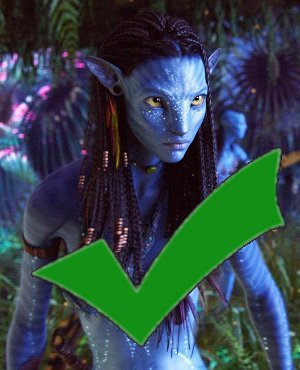
Reason #4: The cats with human boobs suck
Initial assessment: I’m not talking about Aesop/Fantastic Mr. Fox allegorical use of animals to represent people. I’m not talking about Maple Town / Care Bears style “Let’s make our characters animals so they are furry and cute and make good toys” either. I’m talking about this Victoria’s Calico Secret, cheesecake made with a saucer of milk craziness.
Verdict: REQUIRES REVISION
Revised Verdict: The cats with thong-clad human butts suck.
The claim about Avatar I made that attracted the most press concerned the use and overuse of cats with human boobs. I am glad, but also a little sad, that Avatar did not feature nearly as much furry cleavage as I speculated it would. I was glad, because it was one thing about the movie that at least sucked less than it could have, and sad, because it was done for entirely the wrong reasons.
Given the exploitative tone that the movie doesn’t drop for a second, the only reason I can think of that the Na’vi don’t have big bouncing cat boobs is that the Na’vi have eating disorders. The Na’vi’s boobs are of course present and strategically covered by hair or necklaces for the entire movie in an insulting manner, but they are not a focus, because the Na’vi are supermodel skinny — too skinny, in fact, to have large human breasts. So, they have medium-sized breasts that don’t tend to steal much focus. Thank BioGod for small miracles.
Instead, the part of the Na’vi we get to see all the time are their butts. The Na’vi have round, prominent butts that get in shots a lot, and for some reason, they wear thongs, even though they have tails.
Of course, the thongs don’t cover anything — the Na’vi butts are crackless in much the same way their boobs are nipple-less (they apparently evolved in a strictly PG-13 environment). They’re more movie-native “these people preferred to go naked but we can’t show it” thongs than practical garments. I think they have feathers on them or something. Maybe you want to call them loincloths. Whatever.
But the worst, worst, worst part about the sexification of Neytiri and co. was the sex scene at the fancy soul-talking tree. This was so bad that even the people I know who liked the movie a lot (Sheely) heckled it out loud in the theatre.
Hey guys, raise your hand if you thought the Na’vi were going to have sex by joining their braid-wangs together?

Now, raise your hands if you thought they were going to have human-style slow-motion sex that looked like it was pulled from a particularly soft and sensitive Skinemax offering?
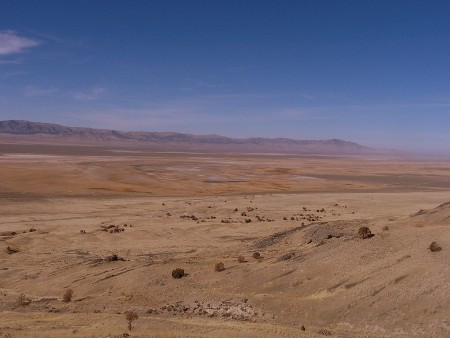
Didn’t think so.
Add that they basically do it all cowboy style at the Na’vi equivalent of the Wailing Wall or the Vietnam Memorial, and it just sucks, so, darned, much!
BTW, why is Neytiri attracted to Jake Jake Bo Bake? Why? All she knows when she sees him is that he is dangerously incompetent and a murderer. Makes no dog-gammed sense.
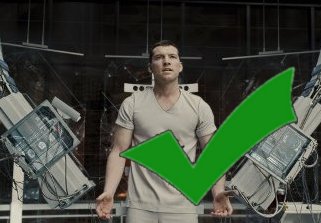 Reason #3: Sam Worthington sucks
Reason #3: Sam Worthington sucks
Initial assessment: Oh, it’s not that Sam Worthington is some terrible actor. The fact that he’s at least a decent actor is part of why he sucks. Other than playing a robot in a steaming pile of crap, his main claim to fame is a super-artistic movie that won all sorts of awards, but that he worked on for seven years.
Verdict: CORRECT
Sam Worthington was serviceable, but mediocre in this movie. “Jake” (Or Sky-Commander Magillicuddy; I’m having fun making up better names up for him) is bereft of personality. He doesn’t want much, he doesn’t decide on much, he flies across the universe in a six-year cryosleep to get functional legs again, but is then all “meh” when he’s actually offered the legs, he betrays the scientists to the army as quickly as he betrays humanity to the Na’vi, and he either really doesn’t care about the dead people in his life (like his twin brother) or he really cares about the dead people in his life (like naked but strategically covered Sigourney Weaver) or, rather, doesn’t (like when he asks BioGod to loot Sigourney Weaver’s ancestral memories for military intelligence).
Jake Sensei MacTavish Johnson just seems totally ambivalent to much of the goings on, which is unfortunate, because his actions are the most important reason why anything in this movie happens. I guess his lack of enthusiasm for his lot in life makes sense, since the only things he does in the live action sequences are lie down, sit down, feel bad about himself and, at certain points, suffocate.
But, as an audience member, this is not my problem. This is Sam Worthington’s problem. Playing a fun, exciting, handicapped action hero isn’t impossible — Carl Lumbley did a fine job of it in M.A.N.T.I.S. (You may know Carl Lumbley as the voice of Martian Manhunter in the Justice League cartoons).
Restrictions breed creativity. Have some fun whydontcha, Jakeinator Salvation.
We’ve already gone over how having to introduce The Los Angeles Jakers as a character twice, having to develop him as a character twice, and having little observable connection between his two introductions and developments results in a flat, boring, overexplained character, but I think it’s important to acknowledge that Sam Worthington’s job here is as the leading man of a blockbuster action/adventure/sci-fi/fantasy movie. This is a much tougher job that most people assume it is.
Think of good leading men in movies in these genres — guys like Arnold, Bruce Willis, Jackie Chan, William Shatner, Harrison Ford, Will Smith, Sly Stallone, William Shatner, Jet Li, Jean Claude Van Damme, and William Shatner: their job is to electrify the audience and raise the stakes on what is going on in the movie. And, their job is to do this even when the writing is bad, nay, especially when the writing is bad.

Conan the Barbarian might still be awesome without Arnold (maybe), but it is more awesome because Arnold is Conan. In the same way, Arnold makes The Sixth Day passably exciting, which is a huge feat that ought to be respected. Bad Boys II is far more exciting and fun to watch because of Will Smith’s performance. There are a lot of kung fu movies — it’s not hard to see what makes The Legend of Drunken Master special, or why Rush Hour has two sequels. Is Under Seige more electrifying, more exciting, more interesting, better to watch, because the cook is played by Steven Seagal? Make fun of the man all you want (he’s earned it, and is laughing all the way to the bank — to stop the guy currently robbing it). You’d better believe it is.
Is Avatar more electrifying because Sam Worthington is Jake? Nope. Is it more exciting? Nope. Is it more fun to watch? In all the praise I’ve heard for Avatar (much of it deserved, though oddly prioritized), I haven’t heard anybody say that Sam Worthington was fun to watch. That’s because he isn’t.
Compare Avatar to Sherlock Holmes, which got a sort of similar mixed reaction from late-2009 savvy movie audiences. Everybody agreed on what was best about it, and most people agreed on what was worst about it — people just didn’t agree on what was important to them. The worst thing was the nonsensical, disappointing villain and plot. The best thing was Robert Downey, Jr. (Well, I liked the cudgel fights, too, but I’m a sucker for a good stevedore cudgel fight.)
Clearly Robert Downey, Jr. did something right in Sherlock Holmes (or at least he did something), because otherwise so many people wouldn’t independently decide to talk about it. What exactly is that thing he did? Whatever it is, Sam Worthington didn’t do it in Avatar.
I cannot tell you how excited I am to see the movie this image is from. It must be a total gas.
It is tricky to nail down how or why good performances, even when they are not ideologically generative expansions on the craft of acting, make a movie better — but they do. That much is clear from anybody who has paid money to look at a moving picture of Charlie Sheen (and a lot of people who haven’t). Even if you don’t know what that quality is that makes the piece more fun to watch, it is there — and in Avatar, Sam Worthington doesn’t have it.
Oh, he does a decent job taking us through Jake The Snake Roberts’ emotional life, but this is a genre film that demands a certain set of performative conventions and aesthetic values be observed — and the rest of the production has a huge action-hero-shaped hole in it. If the flick calls for tap-dancing, sure, give me texture, give me depth, but also give me some frickin’ g-golly darned tap-dancing! For Crimminey’s sake!
You don’t get bonus points for playing well if you’re playing a different song than the rest of the band.
Plug and play

There’s just no angry like epaulettes angry.
By the way, one word on the legacy of Terminator: Salvation. I heard a lot of complaints from people who saw that movie that it didn’t make any sense for the evil robot machinery to have USB ports on it for Sam Worthington, Christian Bale and friends to plug into. I issued a number of these complaints myself.
And yet I have heard nobody make the connection of how much more frickin’ absurd it is that in this movie, Sam Worthington Firewires himself into a bloody dragon.
This is now Sam Worthington’s thing. He plugs into stuff. If he makes a legal drama, he’d better be able to plug into the witness and see her thoughts — or at least plug into the witness stand to take an automatic polygraph. Maybe he’ll play a judge who can plug into the gavel, or a bailiff who can plug into the coffee machine.
At the very least, with skills like his — ambivalence about what the script forces him to do and a willingness to plug into pretty much anything — I can think of a filmic genre where he’d probably find some work.
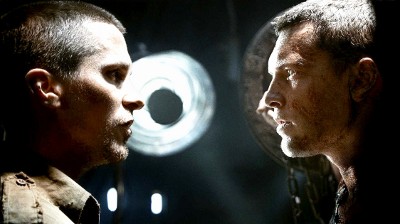
They can even do it in 3D.
Reason #2: John Smith / Pocahontas stories suck
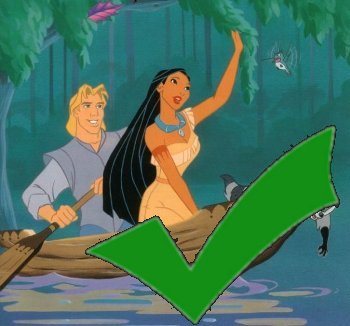 Initial assessment: Every version of the John Smith / Pocahontas story I’ve ever seen treats her as extremely exotic. She has magical powers, she can talk to animals, she has a Sisters of Avalon nature virgin sex goddess vibe going on, whatever. She’s almost always in some sort of slinky imagined Native American garb — more than she wore in real life when with her people, but as it is for the sake of provocation, not accuracy. Pocahontas as superhot crunchy sex spirit is so ingrained in the story that, if the woman isn’t depicted as sexually exotic, if that isn’t one of John Smith’s main motivations in wanting to be with her, it isn’t a Pocahontas story.
Initial assessment: Every version of the John Smith / Pocahontas story I’ve ever seen treats her as extremely exotic. She has magical powers, she can talk to animals, she has a Sisters of Avalon nature virgin sex goddess vibe going on, whatever. She’s almost always in some sort of slinky imagined Native American garb — more than she wore in real life when with her people, but as it is for the sake of provocation, not accuracy. Pocahontas as superhot crunchy sex spirit is so ingrained in the story that, if the woman isn’t depicted as sexually exotic, if that isn’t one of John Smith’s main motivations in wanting to be with her, it isn’t a Pocahontas story.
But if the chief quality of Pocahontas is that she is extremely different from John Smith to the point of not even qualifying as human in any way he can understand, then she fails to build a bridge between peoples — their relationship fails to serve as a lever for communication, mercy and understanding. She actually just further “otherizes” Native Americans and advances the notion that they are not people in the same way white folks are people.
Verdict: CORRECT, CORRECT, CORRECT, CORRECT, CORRECT
Just as the visual effects are the aspect of movie that gets the most praise, this is the aspect of the movie I’ve found to get the most condemnation, and I’m somewhat proud that OTI was so accurate (especially Mlawski’s “Mighty Whitey” comment back in the original thread) in determining how the attitudes and themes of the story it is based on were going to infect and pollute the piece.
We were so right – it was so awful for all the reasons we said it was going to be awful. This quasi-historical narrative misleads with hypocritical messages. This quasi-historical narrative dissuades us from challenging ourselves. This quasi-historical narrative fails to seriously address the problem of the oppression or genocide of native peoples – why it happens, why it is difficult to stop, and what to do about it, both during and after the fact.
But the part about all this that really disappointed me – that just made me so sad – was that it wasn’t enough for the Na’vi to be giant blue people. It wasn’t enough for them to to have a hodgepodge of foreign, native-type looking gear (from earth, but on another planet, ‘natch) – it wasn’t enough for some of them to obviously look black, while others of them obviously looked Native American or Asian. It wasn’t even enough for the most powerful ones to look the most foreign and hostile and inhuman.
No, they had to give them actual magical powers.
In Avatar, being in touch with their environment isn’t a metaphor – it’s real. It’s demonstrable scientific fact. It’s mumbo jumbo #3 – after believing there are space marines and alien planets, after believing there is a technology that lets people become this fictional race of giant blue aliens with their own cutoms, I also have to believe that they have midichlorian-esque disappointingly scientific magical powers. They don’t even really die – they’re part of some sort of crazy hive mind or something. The whole planet is one giant organism – the individuality of the Na’vi is an illusion or close to it.
The Na’vi, for all their Pocahontan Sexitude, aren’t like human beings at all, in any meaningful way – personally, ethically, metpahysically – none of the human rules apply to them, because they do not exist as individuals in a way we can possibly comprehend.
And yet, the Na’vi are just like humans in every way that doesn’t matter at all. They wear human clothes. They have vaguely Calvin Kleinish ideas of hotness. They reinforce our ethnic stereotypes. They have Cable TV sex. They think dragons are awesome.
Even though, you know, they can access the collective consciousnesses of their entire race at will, talk to God directly, and have concrete proof of everything that their human analogs understood either metaphorically, through spiritual contemplation, or merely through aspiration.
How meaningful can it possibly be that Jake decides to take the side of these people when his existence doesn’t resemble theirs except in the most superficial ways? He clearly doesn’t even begin to learn the real differences between being Na’vi and being human – because they are profound. He casts aside his reservations (and goes from learning how to walk to being the best Na’vi warrior in multiple generations) in, again, what appears to be a couple of weeks.
 One thing Sheely and I did agree on – Avatar would be a lot more interesting if the aliens were like people in the important ways, but unlike people in superficial ways – like if they looked like rocks and didn’t appear to move much, but were individually sentient and communicated and built relationships with each other through speech or vibration. If, you know, they didn’t talk to BioGod directly and instead had to deal with the existential problems of being rock aliens and face assault from these other life forms who just showed up out of nowhere making a lot of ruckus for what appears to be no reason – and Jake Clousseau Van Helsing has to learn to talk to them, take on an entirely new body and learn what it means to see the world through their eyes.
One thing Sheely and I did agree on – Avatar would be a lot more interesting if the aliens were like people in the important ways, but unlike people in superficial ways – like if they looked like rocks and didn’t appear to move much, but were individually sentient and communicated and built relationships with each other through speech or vibration. If, you know, they didn’t talk to BioGod directly and instead had to deal with the existential problems of being rock aliens and face assault from these other life forms who just showed up out of nowhere making a lot of ruckus for what appears to be no reason – and Jake Clousseau Van Helsing has to learn to talk to them, take on an entirely new body and learn what it means to see the world through their eyes.
As opposed to, you know, living out the crayon drawings of a 13 year old girl and acting out the poor recounting of events in her middle school history class.
And now, the bonus, brand new reason why Avatar sucks …
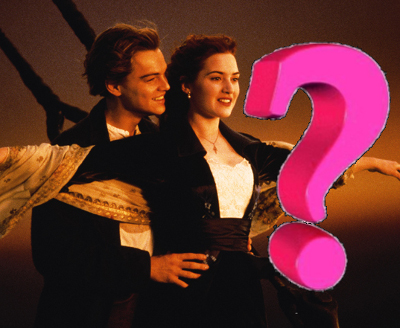 Reason #1:Box offices metrics suck
Reason #1:Box offices metrics suck
There’s some talk that Avatar is going to unseat Titanic as the highest grossing movie ever. I find this repulsive, both because this is a terrible way to judge how good or bad a movie is, and because, well, I use it all the time myself (this past year specifically in reference to the dark iron horse Fast and Furious) and I don’t want Avatar to win.
But, my hypocrisy notwithstanding, there are some very important things to take into account regarding Avatar’s box office numbers.
In 1997, I paid $7 to see Titanic.
In 2009, I paid $15 to see Avatar.
Even adjusted for inflation, this is insane.
I tend to like densely populated places, so these were both fairly high prices for movie tickets at the time, and location isn’t a major contributor toward the change in ticket price. Yes, I saw Avatar in 3D, but the 3D is there specifically to raise the price of the ticket, not because of the higher costs. It’s price inflation disguised as a “value-add.” For the sake of box office numbers, that doesn’t really matter, now does it?
Furthermore, according to the World Bank:
In 1997, combined global gross domestic product was $30.1 trillion in nominal terms.
In 2008 (the latest year of available data), it was $60.6 trillion.
So, between Titanic and Avatar, the price of my ticket more than doubled, and the size of the global economy also more than doubled. Talk about a fair fight.
But, to offer a little more insight, from the same source:
In 1997, the gross domestic product of China in dollar terms was $953 billion.
In 2008, it was $4.33 trillion.
That’s an increase of 354%.
None of this takes into account inflation, exchange rates, PPP, or anything like that. But the important conclusion is that there is a lot more money out there to be made today than there was in 1997, especially overseas, where there are also a lot more movie theaters with much higher ticket prices than there were 13 years ago. Plus, the distribution technology and logistics have caught up with the marketing, so studios can plan truly global launches for movies. They didn’t used to be able to do that, and they lost a lot of momentum for their tentpoles outside the United States.
Avatar is doing significantly better, relative to past blockbusters, overseas than it is doing in the United States. Not that it’s doing anything other than gangbuster business in either place, of course. I called this pretty early on — that if Avatar broke records, the records that would fall fastest would be global. There’s just simply more people out there watching movies, and they have more money to spend on movies, so if you make a movie that almost everybody who watches movies wants to see — which apparently they did with Avatar, kudos for that — it’s going to bring home a bigger haul than movies that people might have liked more, seen more often, or flocked to in greater concentration or with greater enthusiasm.
You don’t think they spent all that $150 million marketing budget in the United States, did you?
Until there is some sort of unified audience response metric that can adjust an individual film’s relative performance for the overall growth of the human population, the global economy, the movie industry and the price of tickets, individual movies will continue to take sole credit for the size of their piece of a larger pie.
And that means Avatar gets to take credit for a decade and a half of seismic global macroeconomic trends, thong-butted cat people and all.
That is, a movie with a ludditic, anticolonial, antiglobalization, anticapitalist message made by a major corporation gets to use the spread of global capitalism, technology and corporate supply chain management as proof that its computer-generated message about a nature goddess resonates with real people (who are also cats).
Overthinkers, I can think of few sentences I have ever written that have sucked more than that one.

Oh, yeah, Fenzel? Here’s five reasons YOU suck: 5. You’re pedantic 4. You don’t edit your posts enough 3. Too many page breaks 2. I am awesome and you are wrong; FAIL! 1. Nobody cares about overeducated late twenty-somethings from New Jersey. RAWR!
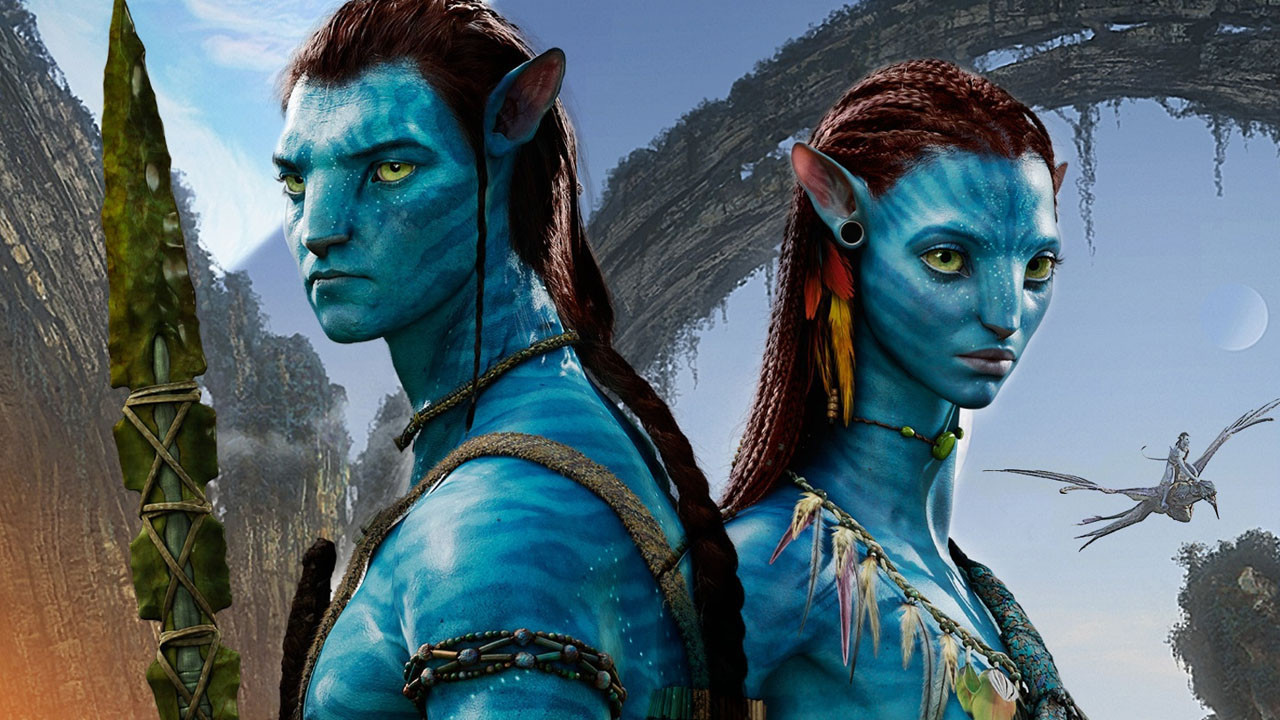
“Avatar would be a lot more interesting if the aliens were like people in the important ways, but unlike people in superficial ways – like if they looked like rocks and didn’t appear to move much, but were individually sentient and communicated and built relationships with each other through speech or vibration.”
So, basically, you want the Horta in the next Star Trek movie?
@Fenzel: I love this article. Thanks for doing it. I’ve been spending most of the last two weeks defending my position on Avatar, and now I no longer have to. I can just send everyone to this post.
@Matt Alvarado: Horta in the next Star Trek movie? Best. Idea. Ever. (“PAIN! AAAAAIGH! PAIN!” — Classic.)
Yea! to the rss feed having the whole article.
Yea! to the awesome article.
Boo! to the fact that for all it’s awfulness and pain; I will join the masses and pay top dollar because this is a movie that should be watched on a big screen, not because watered down characters dressed with Calvin Klein fashion sense in a retread movie make me hot.
Nature is beautiful. We must defend it at all costs. Capitalism is evil. It is soulless and destroying the universe. Eat Burger King!
-A message from James Cameron
I dunno.
As someone who’s dispassionate about AVATAR (thought I didn’t hate it), I wish I could agree with all the points… but you missed what I think is far and away reason #1 the movie doesn’t work: the dialogue.
Cameron’s never been known for his writing. I get that. But while I’m willing to give a pass on the story structure and overfamiliarity — after all, how many stories are similar to those that have been told before? — I can NOT excuse his dialogue. It was the one place he could have actually made it original and/or interesting… no such luck. Absolutely terrible.
Here’s a sample:
Sigourney Weaver: “Hey, numbnuts!”
Michelle Rodriguez: “Get a load of me, bitch!” or “Suck it, bitch!” or “Can you pass me a napkin, bitch?!”
Stephen Lang: [insert random military cliche, like “Hoo-ah!” or “Lock and load!”]; alternately, “Here’s a reference to a movie from 200 years ago, that none of us have ever heard of or seen: ‘You’re not in Kansas anymore!'”
Without halfway believable or decent dialogue, it hamstrings the actors, who for the most part aren’t good anyway (I totally agree re: Worthington). And JESUS — it was like Giovanni Ribisi walked on to the wrong set, giving one of the worst performances I’ve seen in the last few years.
It made me realize: while the marines of ALIENS were about as cliche… that movie was supposed to be fun. A thrill ride. AVATAR, however, is “important.” While it’s also a thrill ride, it’s ultimately a message movie. And I think that hurts it most of all. (Also, compare Paul Reiser — no great actor himself — and the character of slimy corporate weasel Burke from ALIENS. Now compare Giovanni — better actor — and the character of slimy corporate weasel I-can’t-remember-his-name. Night and day. Except that Cameron’s character from 23 years ago was far, far richer and interesting, with about the same number of lines.)
Every time Cameron cut back to the humans, I immediately panicked… because I knew it meant more of his dialogue. As long as we were out running through the landscapes, I was fine with it. (The absolute star of the movie? Weta.)
Finally, I hate to see you bring in talk of box office totals — sure, the media doesn’t account for inflation, but what do you expect? Smart, balanced reporting? Instead, take solace in inflation-adjusted figures, and realize that AVATAR will never, ever have the total audience worldwide as classics like GONE WITH THE WIND, STAR WARS, etc. Isn’t that victory enough?
Yes, the dialogue has horrendous. It was so idiotic, I didn’t even complete the movie. I felt like I was losing brain cells.
Found the criticism spot on. One thing I haven’t heard discussed is how Cameron glosses over the most fantastic idea of his premise, which is the actual mental-assumption of the avatar. With the humans cloning a being sans consciousness, they’ve essentially discovered eternal life. The ability to transfer consciousness from one body to a second (unthinking) one, would eliminate the many moral questions inherent in such an operation were the avatar to possess a sentient mind.
For this technology to have developed in the Avatar-World, I’m sure they’d have to have unlocked a myriad of mysteries of the mind/brain along the way. If they could transfer the data intact, they could potentially upload the same information to a network, and humans could live forever even without bodies, similar to what the Na’vi do biologically.
If the actual avatar body were simply a shell of neurons responding to remote commands from the scientists’ pods, (though it seemed a bit more involved than that to me), then their scientists would still need to possess an incredible understanding of the mind. Because James Cameron decided to focus on the other (less-inspired) visions of future technology like the mech-suits when featuring the humans, he avoided an altogether more intriguing focus. He could have raised new questions or new angles on old questions by asking What is consciousness? What constitutes a living being? If Jake assumes his avatar’s mind, is he robbing that being of its own future experiences, essentially aborting it? A true conflict could arise were the avatar to somehow become sentient and engage Jake in some sort of mind-conflict. Instead Cameron went with Capitalists:bad, natives: good. (By the way, I doubt any rational company would wreak havoc on an eco-system like that; there would be so much more money to be made by mining while still preserving the Life-Trees or whatever, in the ways of medical research, alternative fuels, etc.)
I think it goes along with Fenzel’s point about how the characters don’t reflect enough on their (incredible) situation. Jake gets a new body, and it’s just like “Sweet, now I get to be with my girlfriend.”
I second everything Mlawski said.
And I’ll also second what Brian Williams said (tell Tom I’m still sad he didn’t speak at my college graduation, for me, will ya?). And I’ll piggyback a bit and say I actually was expecting him to go in that “what is consciousness” direction at first, myself. When the hints about the plot started coming out, I thought it was going to be a mental battle between the human and the avatar, not a physical one between the Natives and the colonists. After all, it’s CALLED ‘AVATAR,’ not ‘Na’vi’ or ‘Battle for Pandora’ or anything like that. And, call me crazy, but I thought Cameron would go for something more edgy and less racistImeanunoriginal.
I still have not seen Avatar and I don’t intend to so I can’t really add much to the plot-based analysis that’s been going on, but just wondering – has anyone seen the recent news articles about people who leave Avatar “depressed and suicidal” because they’ll never get to go to Pandora? I mean, are the 3-D effects really that good? I would really, really love to meet one of these people and pick their brain about what they thought of the plot, or if they even noticed it at all.
On a side note, excuse me Avatar Jake, but you best be respecting overeducated New Jerseyans. There are more of us than the Jersey Shore would have you believe.
(And speaking of which, thanks for the Scotch Plains shout-out on 30 Rock, Brian Williams. My whole town was very excited.)
I think the worst thing about Avatar was not its flawed character design or dialogue. (I wasn’t too off-put by either.) What got me was the incredibly cliche’ed conclusion of the film, the macho showdown. This battle played out just as you’d expect it to, and there was very little difference from watching a battle in Lord of the Rings.
Now I actually enjoyed the first hour of the film because I like hardcore science fiction. I thought it was interesting how they made it seem like Pandora was “real,” like it was a place people work and live in. I liked how the Na’vi religion and spiritual stuff was scientifically explained… But once the whole “fight for survival!” stuff came, I felt like I was watching the battle at Pelinor Fields, but with blue direhorses instead of real ones. I was expecting to find a magic ring that controlled the entire Pandora ecosystem.
First of all, however much they spent on it, it was worth it. The movie is just jaw-dropping. I’ve never seen anything that looks remotely close.
HOWEVER… is there such a thing as a movie being TOO beautiful for its own good? I watched it on IMAX, and I don’t think anyone even BREATHED during this thing. No one cheered when something awesome happened, laughed at a joke, or even went to the bathroom (that I noticed). Everyone sat in stunned silence. I honestly think the overpowering visuals got in the way of connecting to the story and the characters.
Then again, it might have been that there wasn’t much to connect to. When I think about my favorite moments of the Lord of the Rings trilogy, a lot of them are Viggo or Ian McKellan doing or saying something awesome – not the big effects. Don’t get me wrong, big effects are peachy. But not to sound like a cliche, but what people loved about The Dark Knight was Heath Ledger, what they loved about Iron Man was Robert Downey Jr., what they loved about Star Trek was the prefect casting in general, etc. Sam Worthington may be a good actor, but he has precious little to do here.
Pete, I’m totally with you about the silliness of the Na’vi’s full frontal attack on the space marines. I can’t believe that was Jake’s master plan. Just charge with bows and arrows. I mean, he of all people should know their firepower and tactics. Can’t the Na’vi at least TRY to flank them or something? Build a couple of Ewok-style booby traps? His argument the scene before that was, “We know these mountains well, and they don’t.” But that doesn’t seem to really help them, does it?
My all-time favorite stupid movie battle tactics has to be The Matrix Revolutions, in which both sides are completely insane. The robots choose to kill hundreds of thousands of humans by literally stabbing them all to death, individually. Instead of, you know, dropping a big bomb, or some nerve gas canisters. And the humans have the ability to release these EMPs that will instantly kill any robot within a mile. And they choose not to do this because… actually, I’ve never understood it. Why, when on the verge of complete annihilation, do they not just use the damn EMP. Instead, Jada Pinkett Smith has to show up and use it. And then she gets scolded for reasons I don’t comprehend.
@Belinkie: “Sam Worthington may be a good actor…” Wow, that took balls.
;p
In all seriousness, though, do you enjoy it when you’re in the theater and people jeer and cheer and make a bunch of noise during the film? I see that happening more at event and hype movies than I do at “serious” ones. So it not happening for you at _Avatar_ was pretty strange, I’ll grant you, given the “event movie” nature it had/has, but I’m not surprised for reasons you yourself said: the script was lacking. The “comedic relief” wasn’t very funny (or at least wasn’t lolworthy- maybe tiny chuckles at most); what should have been big emotional, cheer-worthy moments (like Fenzel’s example of when Mighty Whitey turns down his legs) left a lot to be desired; when the main villain finally gets it; etc. I don’t really think it had to do with the visuals depicted onscreen, but just the lack of awesome in what was *happening* onscreen.
(So as a sidenote, I’ll postulate _Avatar_ was both a success and failure as an event movie. Yeah, it generated a lot of pre- and post-release hype (and is still raking in uber $$$$), but it didn’t generate the emotional experience and group enthusiasm *during the showings* more successful event movies have and do.)
And the reason I think it occurs that way is the nature of the presentation. Event and hype movies generate a sort of group mentality and appreciation, so it feels safer to make noise and stuff when viewing one. Whereas other movies, it doesn’t feel as “right” or “acceptable” to do so. When it *does* happen at “regular” (for lack of a better term) movies, the person is labeled by everybody else as “that” person. “*That* guy.” “*That* gal.” Basically, you’re part of the mob at an event movie if you do something that could be taken as distracting at another kind of movie. In the former, you’re one of many, in the latter, you’re a lone jerk.
And I hardly ever see people get up to go to the bathroom during movies, which is just a practical thing, imo- it costs a lot of $$ to go to the movies, so I assume people want to get their full monies’ worth and stay for every second of the film they possibly can. I know _I_ always go to the restroom right before previews to avoid getting up, and I’ve never been to the movies with people that did things differently. So I have trouble accepting they didn’t take a piss because the movie looked so pretty- my assumption is they already did it. And even without the fiscal aspect, it’s still distracting to get up in the middle of a movie, so again, back to what’s “acceptable” at movie theaters. Do you really want to single yourself out as “That Guy,” the one that couldn’t hold it in for twenty more friggin’ minutes? YEESH! It’s a matter of courtesy to your fellow viewers to relieve yourself in a timely fashion before the movie starts.
Of course, one could argue _Avatar_ was *so* pretty that they wet themselves in their seats.
@Belinkie in re: comment number 2 (you must have posted that as I was typing my first response to you… Ahem…) (so sorry for this double-post)
It sounds rather facetious, but I think your beefs with _The Matrix Revolutions_ are easily explained by the lack of religious (namely Christian) symbolism in the solutions you propose. Killing the robots with the EMP would have taken out opportunity for Neo to act as Jesus, etc. Jada getting scolded? That’s what happens when those Not Chosen try to play God or act above/beyond what God has planned for them- it’s naughty, they need to know their place. Both sides were protected by very blatant Plot Armor, ergo both sides acted totally stupid.
@Ken: I would watch the hell out of blue cat hobbits.
This review speaks the truth about this movie. I love how the story wasn’t denounced for its lack of originality but rather because that story is bad. However, I thought about none of these things when I saw the movie, twice. It’s weird, everything written is true, but I just don’t care.
It’s odd because I agree with the whole story problem, acting problem, and the idea that this article is critical for the sake of being over-critical. However, for people who don’t (I don’t know, write…..review….etc) the problems listed are non-issues. It was a fun movie, not dumb like Transformers but not emotionally character driven like The Blind Side (or whatever, you know, that movie that pulled on your heartstrings and made you think). Avatar uses its visuals to cover up some of these problems. Why not accept this? People don’t go to someone’s house and pick up the couch cushions to see if there’s a stain on the other side. Sure, the stain is there, but no one cares because you can just sit on the clean side.
Besides, now Cameron can write a story in this millenium. The sequel will, if Cameron follows logic, be better. He most likely won’t use a crummy formulaic storyline this time and he can work on his dialogue. This trilogy hopefully will not follow the current progression of sequel qualities. I’m talking about Spider-Man and Pirates of the Carribean.
I think Avatar is the Debbie Does Dallas of special effects porn.
@Tim, thanks for that comment. I think you’ve captured my feelings on this movie and these criticisms of Avatar in your words.
As for the sequel, if I were to trust anyone with making a sequel of anything, it would clearly be James Cameron. Terminator 2. Aliens. ’nuff said.
As for other recent sequel problems, sure, the 2nd and 3rd Pirates movies were crud-tacular, but 2nd Spider-Man movie was quality, no? The 3rd was a stinker, yes, but the first Spidey sequel in some ways exceeded the original.
It seems pretty inevitable that there will be an Avatar sequel, and I think it’ll be significantly better than the original. However, as with most franchises, it’ll start to stink pretty quickly after that point.
My prediction. You heard it here first.
Cameron is a hack, plain and simple. Why not just make a cartoon? Why go through all the time and money to develop this more “realistic” CGI when it borders on the cartoon form anyway. Show a cartoon in 3D; show it in IMAX. This is not ground breaking to me. Making a cartoon look less like a cartoon is not advancing the art of making films. It is advancing the art of making Hack-Films. I would have been more impressed if Cameron was actually creative by stripping off the gimmicks, (i.e. most of the movie) by filming in actual locations and putting actors in blue-laxtex and trying to create a BELIEVABLE world that way. Instead, Cameron creates the most expensive cgi-cartoon ever made. Cameron did indeed advance movie-making, he is the greatest hack who ever directed a movie.
AVATAR: The Sequel
(Several Earth months after the first movie, a NA’VI comes to one of the human research stations to find all the humans preparing to evacuate)
NA’VI: What’s going on? Where is everyone going?
SCIENTIST: Oh dear. We didn’t want to tell you, since there’s nothing we can do about it. A huge asteroid is heading for Pandora. The impact will probably wipe out all life on the surface.
NA’VI: Can’t you do anything? Take us with you!
SCIENTIST: We wish we could, but we simply don’t have enough resources to help you.
NA’VI: But with all your advanced technology, couldn’t you push it out of the way?
CORPORATE HACK: We might be able to, but that will be very expensive. Very expensive. And frankly, without a pesky biosphere in the way, it will be easier for us to get the Unobtanium we need. It’s not like we can live on Pandora without any help, so a devastated surface won’t matter.
NA’VI: Er……..
(Of course, it was the military that diverted the asteroid onto a collision course. But that’s Top Secret…)
Thank you for an excellent article. I wish I had written it, since it sums up my feelings about Avatar perfectly.
Ok, so me and my friend went to see this thing, where both black.
This is important for one reason, the movie is overally racist.
Only when a magic white man comes along do the Navi have any chance at all he’s so special, god talks to him , blah blah.
I could rant on this fact for days, but u know what, I would of been allright with the movie if the antangonist wasn’t so plan bland.
Take the douchbag general from every nam movie, you know the guy who likes war and killing( the big tree attack looked a heck of alot like naplam). Now roll them all into one. Refuse to give him any more of a reason to fight instead of pure rage. And to top it off we NEVER find out what unotitranium is used for, up until mr protagonist talks to god we know NOTHING about the earth being used up. ONE line to make the evil general guy more real is all i ask, a “i have a family to provide for back home, i don’t do this because its fun, i need this money”, instead we get “HELL YEA, IM KILLING SOME BLUE PEOPLE.” Don’t forget that while all the other humans in the movie can not be exposed to the air for more then 5 seconds or so without suffocating, this dude runs out of the air-lock command room and just starts firing at the one pilot who decides they want to abandon the military and fight for the blue people
To top all of this off the navi want to help a human right after seeing them destroy home tree. And since you can scientifically explain the navi’s connection to there land its now important to stop attacking them.
But do you want to know the stupidest part of this entire movie, it’s like district 9 , but instead of enforcing the reality of conquer’s essentially being wrong , although there stronger, the Navi win. District 9 got it right, you see the struggle oppressed people have, and its uncertain what will happen to them, or if they’ll ever be free. Avatar says, naw its happy if the Navi win. One word on the military tactics, im sure they’d just fire a precision guided curse or ballistic missile at what ever they want to destroy. But NOOO , even with your advance technology the forest creatures come to save the day. I’m pissed since i was hyped for this movie, why the F*** did james cameron neglect his plot while coming up with special effects.
This movie needs to be taken as a comedy, the way he bumps into a navi girl that just happens to speak english, how he’s all of a sudden a good person since he gets his freak on and thinks “hey, there not so bad” . We don’t hear any negotiations that break down about a peaceful move, naw, JUST ACTION ACTION ACTION, crap plot, love story, ACTION, somehow protagonist becomes a real navi at the end.
Best looking movie ive ever seen though, just with a crap plot.
I hate it when people disagree so much over which dumb, cliched, stultifying, off-putting aspect of a movie like this is the most dumb, cliched, stultifying and off-putting aspect. Can’t we all get along?
@David – Normally, I’d agree with you. But this isn’t some dumb blockbuster that everyone understands is just there to sell Happy Meals. This movie is probably going to win Best Picture. Let me repeat that: Avatar will most likely be crowned the greatest cinematic achievement of 2009. And because of that, this movie’s flaws MATTER.
On the other hand, everytime I start to preemptively complain about Avatar winning Best Picture, I always then think, “Well, what SHOULD win Best Picture?” That’s the catch – it’s a weak year for movies (thanks writers strike). There were plenty of good movies, but nothing seemed to get much buzz going. Nobody seems EXCITED about anything, except for Avatar. In the end, I think it’ll win partially because none of the other movies have any momentum, and partially because, for all its flaws as a piece of storytelling, it is the single prettiest thing ever made.
Are 3D glasses made from unobtanium?
@Matthew
District 9 obviously, its everything Avatar wants to be and fails to capture and it didn’t suck up hundreds of millions of dollars to make. Its message was more subtly entwined into the action and bolognium rather than being smashed into your face every 10 minutes. I didn’t even particularly like the action sequences but I still left the theater with the feeling I had spent my 10 bucks well.
District 9 is a cupcake, Avatar is a shit filled twinky.
I can’t stand people who can judge Avatar for it’s used story. For Christ’s sake, the story of Star Wars was recycled. Amazing, groundbreaking, visual films like 2001 don’t even have a story much less characters. I can’t stand the fact that people can actually presume to judge the acting of people like Worthington, when they can’t even begin to imagine what it’s like to live as a paraplegic. You all sound like arrogant morons who only feel good about putting down something you can’t emotionally understand.
“Oh, yeah, Fenzel? Here’s five reasons YOU suck: 5. You’re pedantic 4. You don’t edit your posts enough 3. Too many page breaks 2. I am awesome and you are wrong; FAIL! 1. Nobody cares about overeducated late twenty-somethings from New Jersey. RAWR!”
All these years later I still love this series of articles. For all of Avatar’s failures I do thank it for leading me to Overthinking it :)
Stupid Hollywood blockbusters are made for fans of stupid Hollywood blockbusters. EOS
you keep saying he did all this and that in 3 weeks. its not 3 weeks, 3 months..subtle difference. and for anyone who lives in another country would know that can be a huge difference.
and the bigger issue, is that at the beginning during the “plot development” the head scientist complains about being subjected to this jar-head.. but it takes 6 years to get there, and the other recruit had studied her work. so she was there for 6 years waiting for this replacement dead brother and still hadnt moved passed it?
(the movie turns out the best thing ever)
Go f yourselfs, awesome movie. Go make a better one